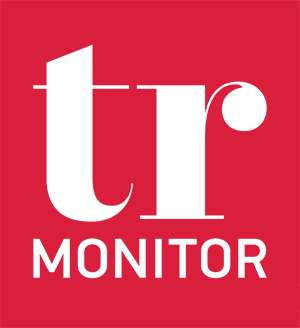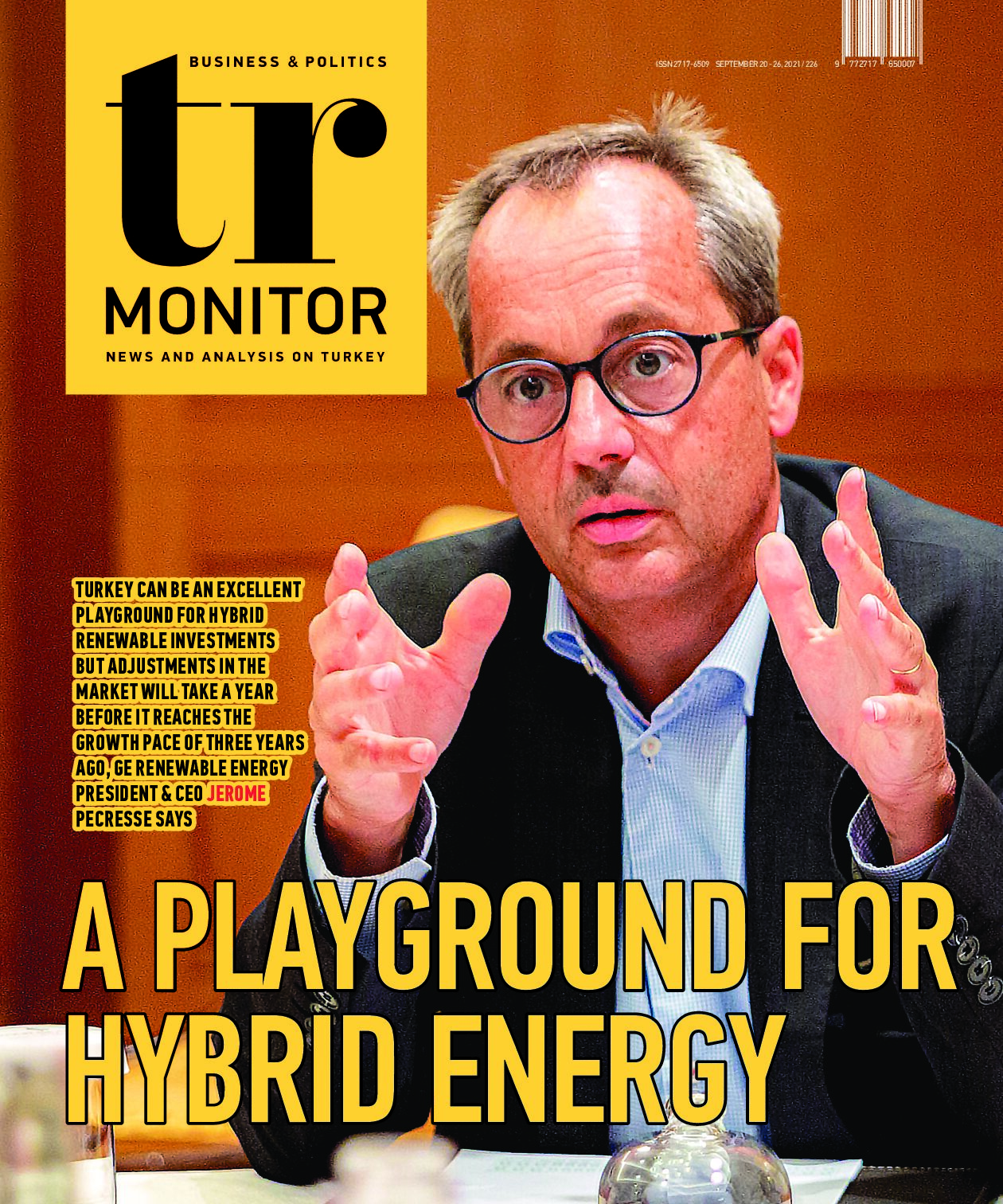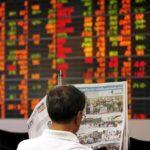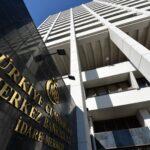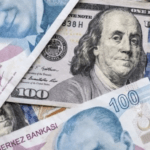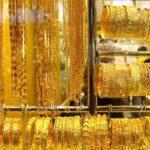By HUSNIYE GUNGOR
Turkey can be a playground for hybrid renewable investments, according to Jerome Pecresse, President & CEO at GE Renewable Energy, who was in Istanbul to meet clients, government officials, talk about the future, discuss Wind Energy Renewable Energy Resource Area (YEKA) auctions and offshore wind potential in the country. He is quite optimistic about the Turkish renewable market in the medium-term, despite his expectation that adjustments in the market will take a year before it goes back to its growth pace of three years ago.
In an exclusive interview with TR MONITOR, Pecresse shared his thoughts about new trends in the renewable energy and Turkey’s potential and current outlook.
The world is primed for an energy revolution, Pecresse said, because the cost of wind and solar electricity is more competitive than the cost of fossil fuels in many parts of the world. “That has been the trend for the last few years. Since wind and solar are very competitive, you see continued growth globally, because they are the cheap option and because governments want to meet their carbon neutral commitments,” he said.
Speaking about the trends in the sector, the issue, he added, is going to become how do you integrate bigger renewable content into the grid system. How the electricity system manages intermittency and other consequences of higher renewable penetrations will be the next big question. “The first solution is combining renewable sources on the same site, meaning putting wind and solar in the same location, maybe one day storage as well. This is what we call hybrid. You can produce during longer periods during the day by doing so.” This trend is starting to be seen in Turkey, he said.
Another option is investment into the grid system, modernization of the grid with better hardware, better control and better software to accommodate higher renewable content. “A third option is offshore wind, which is securing the bigger chunk of wind developments every year. We see continued developments in the European and the U.S markets, which are very active in terms of offshore wind projects. And Asia is developing in places like Japan, South Korea and Vietnam.”
There are good sites in Turkey with very good wind speed at sea, Pecresse said. However, studies should be conducted, particularly on seabed conditions, meaning to make sure the ground is stable for the turbine. “But there is no reason you can’t develop offshore wind projects in Turkey,” he said. “Obviously, it’s important to do more studies including how do you adopt important infrastructure because there are a number of logistics considerations that goes with offshore wind. I am convinced that offshore wind is going to go global very fast.”
On the offshore wind side, GE Renewable has a technology called Haliade-X, a 13MW turbine, the largest technology installed today at twice the size of the biggest onshore wind turbine. The company continues to scale up by providing the turbine, which has been operating as a prototype for 18 months. GE Renewable is already booked with a significant project in the UK, called Dogger Bank Wind Farm A, B&C with 3.6GW installed capacity. There is another large project in the U.S., where they will implement the first large-scale project in the country with 62 giant turbines to be installed in the Atlantic Ocean about 15 miles off the coast of Martha’s Vineyard in Massachusetts, with enough capacity to power 400,000 homes with clean energy. “We are expanding actively in Asia, particularly in Japan, where we announced a partnership with Toshiba. Like onshore, it is a state-of-the-art technology of GE. We are trying to go global very quickly,”
Gebze facility exports 80% of production
Active in wind, grid and hydro businesses, GE Renewable has two major facilities in Turkey which represent the two biggest businesses for the company, according Pecresse. One is the wind blade facility in Bergama, Izmir, employing 800 people; the other is the transformer facility in Gebze in the grid business, which also employs around 800 people. “Two very strategic components, blades for the wind turbine and transformers for the electricity system, are produced in Turkey,”Pecresse said.
The Gebze facility exports 80% of its production while the Bergama wind blade factory is focused on the Turkish market, which is doing well and remains a focus for the company, Pecresse said. “We are starting to look at export opportunities there as well,” he added.
Turkey is one of the top 10 markets globally wind energy with 10GW installed base, and wind conditions are quite good, Pecresse noted. GE Renewable’s installed base in Turkey, where it has been operating for more than 10 years, is 1.75GW, representing nearly 20% of the total market. The company also has its technology in over 60 wind farms.
The Turkish market is promising, according to Pecresse, who said GE Renewable has a number of customers eager to do business. “Today is not the easiest time, with high inflation hitting hard, and with local content requirements which have to be managed, financing, which is not as easy as it used to be years ago.” He stressed that it is harder today to capture the growth potential of Turkey’s onshore wind market that it could have been three years ago. “However,” he predicted, the country will look morepromiing again after a phase of adjustments. “I am quite confident in the medium-term prospects.”
Going beyond borders with Turkish investors
He is also quite confident that Turkey can be an excellent location for hybrid renewable investments with its great wind speed and solar conditions. “Add solar to a wind site or wind to a solar site and you result in better economics and give more value to the system. I think hybrid (wind+solar) will be an important development for the Turkish market in the years to come.”
But to improve and boost renewable energy investments, Turkey should make acquiring permits easier and try to find a balance between local content requirements and the cost of electricity. “Because local content requirements could increase the cost of the turbine and the cost of funding, at some point you need to strike a balance and choose what you want first and by far the most,” he said.
Pecresse noted that their Turkish customers make renewable investments also abroad in countries like Iraq, Uzbekistan and Azerbaijan to help develop renewable there. “That is part of the discussion that we are having here.”
GE Renewable Energy is in a phase where they have paused new investments because of the unpredictable economy and high inflation. The company has invested USD 80m since 2017 in the Bergama facility in Turkey. They are looking at further investment opportunities depending on the demand of blades both for GE and its competitors. “If the market continuous to develop, we will keep expanding in Bergama, adding more lines on the existing capacity for onshore,” he said.
As renewable grows, investments in the grid system will become increasingly important, Pecresse noted. “You will need to invest in expanding and stabilizing the grid to get the full potential. That is going to be next important phase. You have local resources; you’re blessed with wind and solar which is a good thing.”
‘INVESTMENTS IN THE GRID SYSTEM WILL INCREASE’
Globally today, 80% of newly-installed electricity capacity every year is renewable, wind or solar, which GE Renewable Energy President and CEO Jerome Pecresse expects to grow faster than ever over the next 10 years, producing almost 50% of the electricity used every year. There are two factors which are slowing the pace of growth in renewable, according to him. “One is harder and longer permit processes for wind or solar installations in Europe. That explains a large part of the disconnect between the ambition of governments and realization of these installations. Entrepreneurs prefer to repower their existing wind farms and we replace the technology of 10 years ago with state-of-the-art technology. The Second thing is the need to invest in the grid system to take on higher renewable content, such as managing intermittency and frequency regulations.”
YEKA AUCTION IN OCTOBER A TEST OF INVESTMENT APPETITE
GE Renewable Energy President and CEO Jerome Pecresse was in Turkey in early September to meet customers and government officials, look at how the company is doing on current projects, and discuss Wind Energy Renewable Energy Resource Area (YEKA) auctions, including offshore wind. “Some might be afraid of adjustments because the feeding system was very effective in driving growth in the market while promoting local production content. Now the market will be dependent on the extension of ongoing projects, or the success of YEKA auctions,” he says. A new YEKA auction in October will be a test for the investment appetite, he adds. But there might be a year of adjustments before people find the most efficient economic model within the new system, which has some constraints on the financing side, according to him. He thinks that the need for government incentives for renewable investments is decreasing globally because of the cost competitiveness of renewables. “The question now is how do you manage intermittency with hybrid and restorage with hydro? People tend to forget that the hydro business is renewable and is a very good way to store electricity. It is important to invest in the grid.”
OFFSHORE WIND TO GROW BY 7-FOLD BY 2030
>> 6,100 MW new offshore wind plant capacity was established in 2020 despite the pandemic, according to Offshore Wind Report by the Global Wind Energy Council (GWEC.) GEWEC expects to break a new record with 12,710 MW in new installations.
>> Adding more than 3,000 MW of offshore wind capacity in 2020, China maintained its leading position in the world for the third year. China’s wind installations are estimated to be 7,500 MW this year, followed by Europe with 2,890 MW and Asia with 2,330 MW.
>> The report expects to offshore reach 235,000 MW capacity by 2030 with current policies, a 7-fold increase. However, this increase corresponds to only 11% of the capacity needed to meet net-zero emissions targets by 2050.
>> The world has so far installed only 2% of the offshore wind capacity that will be needed by the middle of this century to avert the worst climate change impacts.
>> The 35,000 MW offshore wind capacity currently installed around the world prevents 62.5 million tonnes of CO2 emissions. This is equivalent to pulling 20 million cars out of traffic.
>> The sector provides employment to 700,000 people.
